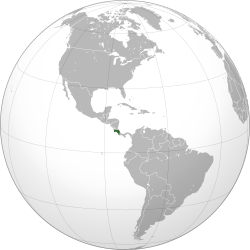
Excerpts from the Peace Corps Welcome Book:
GEOGRAPHY: "The Republic of Costa Rica is located in Central America, with Panama to the south, Nicaragua to the north, the Caribbean Sea to the east, and the Pacific Ocean to the west. It covers a land area of 19,652 square miles, about the size of West Virginia. A chain of volcanic mountains runs through the center of the country into Nicaragua, splitting Costa Rica in two. In the center of the mountain ranges is a high-altitude plain, with coastal lowlands on either side. Much of the country was once covered with dense forests and jungles, most of which have been cut down to provide farmland. There has been a concerted effort to preserve what is left by the creation of a national park system, which covers almost 12 percent of the country, and forest reserves and indigenous reservations boost the protected land area to 27 percent. Costa Rica is famous for its great diversity of tropical flora and fauna."
ECONOMY: "Costa Rica’s major economic resources are its fertile land and frequent rainfall, well-educated population, and attractive ecological diversity. Its location in the Central American isthmus provides easy access to North and South American markets and direct ocean access to Europe and Asia. The economy of Costa Rica has been dependent on the production and export of bananas and coffee. While these products, along with sugar cane and beef, are still important, tourism, manufacturing, and services have surpassed agriculture’s contribution to gross domestic product and diversified the economy. Costa Rica has also successfully attracted important foreign investments in free-trade zones by large international companies. Tourism is booming and now earns more foreign exchange than bananas and coffee combined. The government still holds controlling interests in many sectors of the economy, particularly in telecommunications, electricity, and banking. Costa Rica continues to strive to widen economic and trade ties both within and outside the region.
Nearly one-quarter of Costa Ricans live below the poverty level and the gap between the rich and poor continues to widen. Therefore, while you will see visible affluence, including modern shopping malls, just-released American movies, well-developed tourist resorts, and the latest-model cars on the streets of San Jose, you will live and work with people who do not have access to such privileges."
GOVERNMENT: "Costa Rica is a democratic republic with strong constitutional checks and balances. Executive responsibilities are vested in a president, who is the country’s center of power. There also are two vice presidents and a 15-member cabinet, which includes one of the vice presidents. The president and the 57 Legislative Assembly senators (diputados) are elected for four-year terms. An independent Supreme Electoral Tribunal supervises the electoral process. The Supreme Court of Justice exercises judicial power and a chamber of the Supreme Court reviews the constitutionality of legislation and executive decrees and all habeas corpus warrants... The government of Costa Rica has emphasized the development of democracy and respect for human rights throughout its history. Until recently, the country’s political system contrasted sharply with those of many of its Central American and Caribbean neighbors."
DEMOGRAPHY: "Costa Ricans, commonly known as ticos, are predominantly of Spanish descent. There are smaller groups of people of Black Afro-Caribbean (3 percent), indigenous AmerIndian (1.7 percent), and Asian heritage (1 percent). Costa Rica also hosts many refugees, mainly from Colombia and Nicaragua. Migrants from Nicaragua make up almost 10 percent of the population. Spanish is the national language, although many people on the Caribbean coast speak English and patois (a form of Creole English). The population of Costa Rica is approximately 4.2 million; 59 percent are urban and 41 percent are rural, with more and more people moving to urban areas. Most people belong to the Roman Catholic Church (70 percent), although the congregations of Evangelical churches are growing (14 percent)."


No comments:
Post a Comment